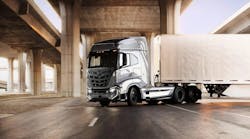When it comes to the chicken or egg question Nikola Motors has struggled with regarding its hydrogen fuel cell electric vehicles and refueling station network, executives seem to have settled on the answer: both, in moderation. The company, which released its earnings results on Tuesday, grew its network and vehicle deliveries substantially in the first quarter.
On the vehicle side, Nikola produced 43 FCEVs and wholesaled 40, exceeding the previously stated goal of 30-35 deliveries for the quarter and bringing its wholesale total to 75 trucks in its first two quarters of serial production. Part of those deliveries were part of deals with port drayage company IMC and AJR Trucking for 50 FCEVs each; so far, Nikola has delivered 20 trucks to IMC (No. 45 on the 2024 FleetOwner 500: For-Hire list).
Executives also said Nikola had delivered its first remediated battery electric vehicles during the quarter, with plans to complete the return of the units by year-end after they were recalled last year due to fire-prone battery packs. CEO Steve Girsky also spoke about the “future proof[ed]” BEV 2.0, which are now closer to the FCEVs with its battery and operating systems, allowing for over-the-air updates.
Nikola’s hydrogen business is also seemingly in a good spot: the first modular Hyla refueling station opened in Ontario, California, in February, shortly followed by another in Long Beach. These stations are part of Nikola’s larger Hydrogen Highway Plan to create a network of hydrogen refueling stations and mobile refuelers throughout Southern California. Originally, leaders had expected to build nine refueling stations in 2024 but updated that guidance to 14 total refueling solutions (these include mobile refuelers and partner stations in addition to Hyla sites) by year-end, with nine of those by mid-2024.
“We want to emphasize that building the hydrogen ecosystem requires industry-wide collaboration for the benefit of all. We need partners and they come in different forms and stages of infrastructure development.” Girsky said.
See also: Nikola doubles Q4 revenue, delivers first hydrogen fuel cell trucks
But Nikola’s not in the clear: Truck production and revenue were both down roughly 30% each year over year, coming at 43 trucks built and $7.5 million in revenue. The revenue is half the $15.8 million analysts expected. The gross loss of $57 million, more than twice Q1 2023’s number and a 34% decrease from last quarter.
CFO Tom Okray attributed part of the disappointing finances to “the fulfillment of a number of lower-priced legacy deals,” which drove down the average sale price, although he expects ASP will pick up through the year as Nikola transitions away from such deals.
Going forward, Nikola expects to produce 300-350 FCEVs in 2024, with a target of 50-60 in Q2. While there are no concrete plans to sell the on-hand BEV inventory, executives said they intend to do so “opportunistically” in 2025.
Girsky and his team are still optimistic about Nikola’s future, saying that they “continue to move forward rapidly and execute [their] plans.
“And please keep that in mind—we are in the execution phase, not the planning or concepting phase,” he said. “Last quarter, I talked about getting on the field with the first deliveries of our hydrogen fuel cell electric trucks. Today, we are executing plays, competing, and cultivating more green shoots as we expand upon current markets and enter new ones.”
Shares of Nikola (Ticker: NKLA) have been up and down over the past six months, hitting a YTD high of $1.15 per share and a low of $0.58 per share in April. Nikola reported results after the bell on Tuesday morning, and its share price has fluctuated since. As of writing, it sits at $0.60 per share and its market capitalization is $820 million.



